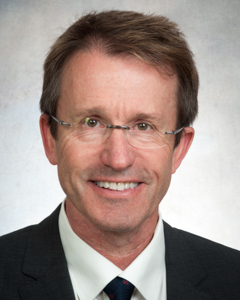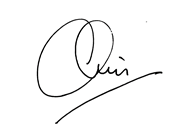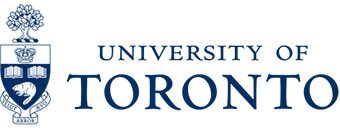
Dr. Christopher R. Forrest
“Innovation is creativity with a job to do.”
— John Emmerling
“Mindless habitual behavior is the enemy of innovation.”
— Rosabeth Moss Kanter
“When you are a Bear of Very Little Brain, and you Think of Things, you find sometimes that a Thing which seemed very Thingish inside you is quite different when it gets out into the open and has other people looking at it.”
― A.A. Milne, Winnie-the-Pooh
Let me start by wishing all of you a belated Happy New Year with health, happiness, safety and prosperity for the months to come.
It is already more than halfway through the first and coldest month of the year so it can only get better from here right? And besides, the days are getting longer!
Last Chair’s Comments, I expounded about the aspects of creativity that are integral to our specialty. This time, it’s innovation. According to the Merriam-Webster dictionary, innovation involves “the act of introducing things or methods that are new”. What is interesting to me is the “butterfly” effect of innovation. One thing influencing something seemingly unrelated. Did you know that the English innovation of using coal to make glass in 1611 was integral to development of the champagne world market? French glass was wood-fired, intrinsically weak and prone to failure making storage of the effervescent liquid problematic. English coal-fired furnaces burned at higher temperatures and allowed for stronger glass production. Reinforced English glass bottles (“verre anglais”) resulted in preservation of sparkling champagne and replaced wooden casks thereby allowing it to be transported long distances. The rest is history (true story). New stuff happens every day. It is hard to keep up with innovation. In fact, it can be overwhelming. Especially for someone of my era. Ask your 15 year-old son about the latest in android phones and you will get a snarky answer and withering look of derision.
I know very little about the innovative process. But I recognize it when I see it and I am one of the first to try and glom on to whatever momentum has been generated as the result. “Never the first and never the last” is a good philosophy that was taught to me by one of my old and long forgotten professors. Innovation is all around us in surgery. Self-inflating tissue expanders, sophisticated electrical nerve stimulators, vacuum-assisted wound closures, magnetic bone distraction devices… somebody with a bright idea and the energy to see it through… and hey presto, surgery as we know it changes for the better. However, while we are all used to learning about these new and unique technical innovations in surgery, I suspect the truly powerful forces of innovation are in the arena of health care policy management.
To this end, I attended a conference at Harvard in Boston, MA early last November called ICHOM (which stands for the International Consortium on Health Outcomes Measurement) (www.ichom.org). The sub-context of the meeting was “What matters most” and the focus of the event was the development of health care outcomes that mattered to the patient. It was a highly stimulating and remarkable meeting that attracted over 400 people involved in all tiers of health care from around the planet. ICHOM is the brain-child of one Michael Porter, Bishop William Lawrence University Professor, Harvard Business School. Yes, that same Michael Porter who advises President Obama on state of health care in the US and is a leading authority on competitive strategy and economic development of nations, states, and regions.
“What I’ve come to see as probably my greatest gift is the ability to take an extraordinarily complex, integrated, multidimensional problem and get arms around it conceptually in a way that helps, that informs and empowers practitioners to actually do things”.
— Michael Porter
This ability was in evidence in Boston as Michael Porter and his team deconstructed and reconfigured the values attached to modern day health care by highlighting the importance of focusing on what matters most to the patient. Now most of you are puzzling about what is innovative about this concept. But how many of us really know what actually matters most to a patient? We may think we know. But studies have shown that patient motivation and surgeon awareness are not necessarily congruous. Look at the literature on effective patient-physician communication in the health care field and you will not be surprised to discover that it is demonstrably inadequate. If that is the case, how can we know what it important to the patient?
Well, the answer rests in the innovative opportunities being explored by ICHOM that have generated a mechanism for just that. Guiding principles include (a) the creation of condition specific metrics defining outcomes for the full cycle of care for a medical condition, not just based on the specialty or the procedure, (b) recruiting clinicians from all involved specialties to define a standard outcome set focusing exclusively on those that matter to patients, including patient-reported outcomes and (c) allowing clear definitions, time points and data sources so that comparisons can be made across different systems. A series of standard sets have been generated in the treatment of conditions such as prostate cancer, depression and brain tumors to name a few. These are now available and being applied across the world. In fact, the SickKids Cleft Team under Dr. Karen Wong, was integral in forming the cleft lip/palate standard set.
What is driving this is an overwhelming recognition that the values we place on our health care system are flawed and that the cost of doing what we currently do is unsustainable. As the result, adapt or die is a reality that we can’t afford to ignore – this leads to many countries around the world examining their business of health care and making some radical changes. Why is this all relevant? Intuitively, as clinicians, we want to do what is best for the patient. We all want happy and satisfied patients (happy patient, happy life). But perhaps, more pervasively, the people who fund what we do want value for their money. Therefore, by being proactive and defining value based on the health outcomes that matter to the patient in context of the cost of delivering those outcomes is a paradigm that will affect how we deliver health care in the future.
This is already in motion around the world. At the meeting, Dutch Health Care Minister has called 2015 “The Year of Transparency” and is moving the health care system towards international comparisons based on the ICHOM outcomes. Sweden has initiated a hospital transformative system that is based on PRO measures and value-based health care. The call for accountability in the UK has mandated that cardiac surgeons publish their mortality rates – the fact that this initiative has been led by cardiac surgeon and Medical Director of the NHS, Sir Bruce Keogh, has given it some legs.
My leadership philosophy has never been aligned with the “burning platform” approach. I prefer the What/How/Why “golden circle” of Simon Sinek (check it out www.youtube.com/watch?v=qp0HIF3SfI4). But we do have to be cognizant and reactive to what is going on around us. And I am pleased to recognize that as a specialty, I think we are ahead of the curve on this concept. The “Q” team features prominently. Innovative qualitative research on patient-reported outcomes (PRO’s) initiated by MacMaster University professor Anne Klassen and New York MSK Plastic Surgeon Andrea Pusic in the area of breast surgery has spawned a phenomenal super nova of activity with the development of the Cleft-Q, Face-Q, Body-Q, Scar-Q to name a few. Momentum in this area is sure to be gained at the upcoming PRO meeting in Washington at the end of this month. But there is a lot more that we can do. “Mindless habitual behavior” will not get us to where we should be. All of us have the opportunity to be the “why” of our respective subspecialties and drive the “how” and the “what”. Demonstrating the motivational forces and values that patients are expecting is key.
So how does one get started on something like this? These are the basic principles:
- Identify patients with similar needs
- Define patient relevant outcomes engaging both patients and health care providers
- Secure ability to monitor health outcomes and costs for each patient group
- Organize care to maximize value for each group
- Engage with experienced providers
- Organize steering models and rulebooks to enable and stimulate value development
- Re-invest where the value is
This is obviously a big job… but it has to start somewhere. Data-sharing, formation of special interest groups, developing networks, engaging patients and taking a lead role are all things we can participate in.
Here the butterfly effect comes into play again. Understanding what matters to our patients allows us insight and opportunity to influence health care policy. In the health care world, data is power. We can be better at collecting data.
Globe and Mail columnist Jeffrey Simpson was a key note speaker at the CSPS meeting in Montreal last June and like Michael Porter, he likened the current trends in health care policy to a form of global warming that we cannot ignore (read his book Chronic Condition – eye opening, btw). “Provider organizations are understanding that, without a change in their model of business, they can only hope to be the last iceberg to melt” is Michael Porter’s warning to us all. So how does this all come back to innovation? As Dylan sang “for the times they, they are a-changing” and while I don’t want to announce that the sky is about to fall, as a specialty that takes pride in its creativity and innovative skills, we have to pay attention to what is going on around us and be the drivers of change and not passengers at the back of the bus.
And finally, a little late but here is my list of the division highlights for the past year!
Top Ten for 2014:
- A facelift for the Division of Plastic and Reconstructive Surgery Website and newsletter: For those of you who haven’t checked it out yet: www.uoftplasticsurgery.ca. Huge thanks to Helen Rubtsov and AR Studio for all their great work.
- Four for four: Congratulations to the graduating class of 2014: Drs. Sheikhan Al-Hashmi, Olivia Ho, Matthew Plant and Matthew McRae.
- Awards for the division: Dr. Greg Borschel, George Armstrong Peter’s Prize given to a young investigator who has shown outstanding productivity during his/her initial period as an independent investigator (second year in a row for the Division of Plastic and Reconstructive Surgery), Dr. Ron Zuker, CSPS Lifetime Achievement award, Dr. Manuel Gomez, one of “10 Most Influential Hispanic Canadians” in 2014, Cho Pang PhD, Senior Scientist, The Hospital for Sick Children, was recognized for a lifetime of achievement and dedication to the Department of Surgery, Dr. Robert Knowlton (1934 – 2014) Division of Plastic & Reconstructive Surgery Lifetime Achievement Award, Dr. John Semple: “Cause Leadership Award” from the Canadian Breast Cancer Foundation, Dr. Ron Levine: Sustained Excellence in Community-Based Teaching Award from the Faculty of Medicine, UofT, Dr. Siba Haykal: Hugh G. Thomson Humanitarian Award and Dr. Heather Baltzer who received the 2014 GAM Canada Scholarship Award.
- Surgeon Scientist Program Graduate: Dr. Mike Hendry (Supervisors: Dr. Greg Borschel and Tessa Gordon).
- Staff Promotions: Dr. Toni Zhong (UHN: Associate Professor), Dr. Manuel Gomez (St. John’s Rehab: Associate Professor), Dr. Michael Weinberg (Trillium Health Center: Assistant Professor), Dr. Shahriar Shahrokhi (Ross Tilley Burn Center: Assistant Professor) and Dr. Frank Lista (Trillium Health Centre: Assistant Professor).
- In the news: One of the highlights of the past year was seeing some of the great work that our division members were involved in.
Dr. Oleh Antonyshyn’s mission to the Ukraine with Dr. Steve McCabe, Siba Haykal, Rayisa Hontscharuk and Tara Lynn Stewart. Dr. Steve McCabe’s coverage for composite vascularized allotransplantation for upper extremity.
SickKids Herbie Fund coverage of twins from the Philippines for craniofacial surgery and Divisional involvement with the annual BRA Day event. - Annual Resident Research Day: The highlight of the divisional academic year with Tau Omicron Visiting Professor, Dr. Paul Cederna from University of Michigan, Ann Arbor.
- Divisional global outreach in all parts of the world: Ethiopia, India, Bangladesh, Uganda, Ukraine, Jordan, and Qatar.
- Local UofT CME events: Upper Extremity Update, UofT Breast Symposium, UofT Aesthetic Symposium, Lindsay-Thomson Pediatric Plastic Surgery Day, 13th Annual Ralph T. Manktelow Day, KLS Martin Craniofacial Lecture series, Toronto Obstetrical Brachial Plexus Palsy Workshop and the first GTA lecture series to name a few.
- An all-female crew of phenomenal new PGY-1 residents into the Plastic Surgery family: Miliana Vojvodic, Stephanie Dreckmann, Melissa Roy and Helene Retrouvey.
And as always, many many thanks to Kathy Pavlovic for holding things together…

Christopher R. Forrest, MD, MSc, FRCSC, FACS
Chair, Division of Plastic and Reconstructive Surgery
Chief, Division of Plastic and Reconstructive Surgery
Medical Director, HSC Centre for Craniofacial Care and Research
Department of Surgery, Faculty of Medicine
University of Toronto

